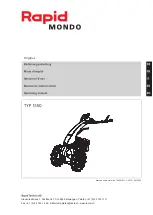
Operation
Note:
Determine the left and right sides of the
machine from the normal operating position.
Before Operation
Before Operation Safety
General Safety
•
Do not allow children to operate the machine.
Allow only people who are responsible, trained,
familiar with the instructions, and physically
capable to operate the machine.
•
Working with this machine is strenuous. You must
be in good physical condition and mentally alert. If
you have any condition that might be aggravated
by strenuous work, check with your doctor before
operating this machine.
•
Shut off the engine and wait for all moving parts
to stop before leaving the operating position.
Disconnect the spark-plug wire (and keep it away
from the plug to prevent accidental starting) and
allow the machine to cool before unclogging,
fueling, inspecting, adjusting, servicing, cleaning,
or storing it.
•
Become familiar with the safe operation of the
equipment, operator controls, and safety signs.
•
Do not operate the machine without proper shields,
guards, or other safety protective devices in place.
•
Keep the operating area clear of all persons,
particularly small children, and pets.
•
Thoroughly inspect the area where you will use
the equipment and remove all foreign objects.
•
Become familiar with all the safety and operating
decals on the machine and its attachments or
accessories.
•
Do not use the machine above underground
utilities, including water lines, gas lines, electric
cables, or pipes.
Fuel Safety
•
Use extreme care in handling fuel. Fuel is
extremely flammable and its vapors are explosive.
•
Do not refuel the machine indoors. Fill the fuel
tank outdoors with extreme care.
•
Extinguish all cigarettes, cigars, pipes, and other
sources of ignition.
•
Do not remove the fuel cap or add fuel to a hot
or running engine.
•
Allow the engine to cool before refueling.
•
Do not overfill the fuel tank. Replace the fuel cap
and tighten it securely. Clean up spilled fuel before
starting the engine.
•
If you must drain the fuel tank, do it outdoors.
•
Use only an approved fuel container.
•
Do not fill containers inside a vehicle or on a truck
or trailer bed with a plastic liner. Always place
containers on the ground away from your vehicle
before filling.
•
Remove fuel-powered equipment from the truck
or trailer and refuel it on the ground. If this
is not possible, then refuel such equipment
with a portable container rather than from a
fuel-dispenser nozzle.
•
Keep the nozzle in contact with the rim of the fuel
tank or container opening at all times until fueling
is complete. Do not use a nozzle lock-open device.
•
If you spill fuel, do not attempt to start the engine
but move the machine away from the spill and
avoid creating any source of ignition until the fuel
vapors have dissipated.
•
If you spill fuel on your clothing, change your
clothing immediately.
•
Do not store the machine with fuel in the fuel
tank or the fuel container inside a building where
ignition sources (an open flame, spark, or pilot
light) are present, such as on hot water and space
heaters, clothes dryers, etc. Allow the engine to
cool before storing in any enclosure.
•
Fuel is harmful or fatal if swallowed. Long-term
exposure to vapors can cause serious injury and
illness.
– Avoid prolonged breathing of vapors.
– Keep your hands and face away from the
nozzle and the fuel-tank opening.
– Keep fuel away from your eyes and skin.
9
Содержание 58630
Страница 2: ......
Страница 22: ...Notes ...
Страница 23: ...Notes ...
Страница 26: ......
Страница 75: ......
Страница 76: ......












































